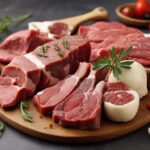The richness of gastronomy throughout history is a compelling tale of innovation, discovery, and evolution. From the first sparks in primitive fires to today’s high-tech stovetops, the history of cooking has been an unceasing journey of creativity and change. This article will delve into some of the most momentous moments that have left an indelible mark on the vast canvas of the world’s gastronomy.
The Invention of Cooking: From Fires to Modern Stovetops
The starting point in our gastronomic odyssey takes us to the dawn of civilization when our ancestors discovered the art of cooking. Initially, primitive fires provided the necessary heat to transform raw foods into rudimentary dishes. However, the true culinary revolution came with the invention of stoves and the development of more advanced techniques.
The Era of Fires: The Origin of Cooking
In primitive societies, food preparation began with the mastery of fire. Fires were the epicenter of culinary activity, where raw meats and vegetables were roasted to perfection. This simple act marked the beginning of a symbiotic relationship between humans and food, taking us from subsistence to gastronomy.
From Fires to Stovetops: An Evolutionary Leap
Over time, humanity experienced an evolutionary leap by developing more elaborate structures for cooking. Primitive stoves, made of stone and clay, allowed greater control over temperature and cooking duration. This innovation not only facilitated food preparation but also influenced the diversification of the human diet.
The Revolution of Domestic Cooking
As societies evolved, cooking ceased to be a communal outdoor activity and moved to more dedicated spaces within homes. Specialized utensils such as pots and pans emerged, facilitating the creation of more complex dishes. This transition marked the beginning of domestic cooking and the cultivation of family traditions around food.
Modern Stovetops: Technology and Sophistication
The passage of time and technological advances led to the creation of modern stovetops. Equipped with cutting-edge technologies such as induction and convection, these appliances not only simplify the cooking process but also offer greater control over temperature and cooking time. Cooking, once a basic survival task, has become a sophisticated art that combines science and creativity.
The Spice Age: Navigating New Flavors
The second chapter of our gastronomic journey transports us to the fascinating “Spice Age,” a period in history where trade routes became paths of culinary exploration. This chapter not only marked a transformation in cuisine but also contributed to the creation of global connections through the quest for exotic flavors.
The Quest for New Culinary Horizons
During the 15th and 16th centuries, major European maritime powers such as Portugal and Spain embarked on bold expeditions to establish direct trade routes with Asia. These expeditions had a clear purpose: gaining access to coveted spices that would not only enhance the taste of food but also act as natural preservatives.
Spices: The Gold of the Era
Spices, including cinnamon, pepper, cloves, nutmeg, and more, were so valuable that they were considered equivalent to gold. Their transportation from Asia to Europe involved perilous journeys, but the allure of these unique flavors fueled the determination of explorers and traders.
Transformation of European Cuisine
The arrival of spices in Europe radically transformed the continent’s cuisine. Previously, food had been seasoned mainly with local herbs, but the incorporation of Asian spices added an entirely new dimension to flavors. Once-simple dishes became exquisitely complex, and spices became symbols of status and luxury.
Impact on Medicine and Economy
In addition to their use in cooking, spices were also valued for their medicinal properties and their ability to preserve food. This dual purpose further increased their demand and contributed to the development of herbal medicine. Moreover, the spice trade played a crucial role in the global economy, shaping trade routes and establishing cultural bridges between East and West.
Legacy of the Spice Age
Today, many of the spices that were highly prized in the Spice Age are common in our daily kitchens. However, their legacy endures not only in our dishes but also in how we understand global connection through food. The Spice Age not only enriched our palates but also triggered a culinary revolution that resonated through the centuries.
The Creation of Haute Cuisine: Culinary Art in Development
In the 19th century, a revolutionary culinary movement took shape in France, giving rise to the creation of haute cuisine. This period marked a radical shift in how gastronomy was perceived and practiced, elevating cooking to a refined art and establishing standards that continue to influence contemporary cuisine.
The Emergence of Haute Cuisine
In the early 19th century, post-revolutionary France witnessed the emergence of a group of visionary chefs seeking to transform cooking from a mere necessity into an artistic expression. Auguste Escoffier, known as the “king of chefs and the chef of kings,” was a central figure in this movement.
Establishment of Culinary Standards
Escoffier and his contemporaries were not only skilled chefs but also meticulous organizers. They introduced the kitchen brigade, a hierarchical structure that efficiently organized work in the kitchen. Additionally, they formalized recipes and techniques, establishing precise standards that would form the foundation of haute cuisine.
The Importance of Presentation
A distinctive element of haute cuisine was the importance given to the presentation of dishes. Aesthetics became an integral part of the gastronomic experience, and tableware and food arrangement became as significant as the taste itself. This attention to detail contributed to the creation of a complete culinary experience.
Innovations in the Kitchen
During this period, numerous innovations were introduced in the kitchen. From the classification of mother sauces to the introduction of new preparation methods, such as sous-vide cooking, haute cuisine became a field of constant experimentation and refinement.
Global Expansion of Haute Cuisine
The influence of haute cuisine was not confined to the borders of France; it spread worldwide. Culinary schools and haute cuisine restaurants began to emerge in various regions, carrying with them the teachings and techniques developed in the culinary epicenter of Paris.
Legacy of Haute Cuisine
The legacy of haute cuisine endures today. The principles established in this period remain the basis of modern culinary training, and many contemporary chefs look back with admiration and respect for the rich tradition of French haute cuisine. Furthermore, the focus on quality, presentation, and innovation continues to define culinary excellence worldwide.
The Renaissance of Regional Food: Celebrating Culinary Diversity
In the 20th century, gastronomy underwent a renaissance that focused on valuing regional culinary traditions. This movement celebrated the diversity of local ingredients and cooking techniques, revitalizing appreciation for authentic gastronomic roots and highlighting the importance of regional flavors.
Rescuing Local Traditions
As globalization began to homogenize culinary experiences, a resistance movement emerged. Chefs and food enthusiasts started rediscovering and rescuing local culinary traditions that were at risk of disappearing. Movements advocating for the use of indigenous ingredients and cooking techniques passed down through generations were formed.
Diversity of Ingredients and Flavors
One of the highlights of this renaissance was the appreciation of the diversity of ingredients available in different regions. Chefs began to explore and highlight unique local products, from varieties of fruits and vegetables to indigenous meats and fish. This not only boosted the local economy but also enriched tables with authentic and varied flavors.
Regional Food Restaurants
In response to the demand for authenticity, restaurants specializing in regional cuisine emerged. These establishments not only offered traditional dishes but also educated diners about the history and culture behind each recipe. The culinary experience became a sensory and cultural journey.
Local Gastronomic Events
The renaissance of regional food was also reflected in the proliferation of local gastronomic events. Food festivals, fairs, and culinary competitions became platforms to celebrate the richness and diversity of local culinary traditions. These events not only attracted the local community but also drew visitors interested in exploring culinary authenticity.
Impact on Sustainability
This focus on regional food not only had cultural implications but also environmental ones. By highlighting local ingredients, sustainability was promoted by reducing dependence on imported foods. Additionally, a stronger connection between local producers and consumers was encouraged, strengthening local communities and economies.
Legacy of the Renaissance of Regional Food
The legacy of this renaissance endures today. The appreciation for regional food has influenced how we choose and enjoy our meals. Chefs continue to explore and reinterpret local culinary traditions, and consumers seek gastronomic experiences that celebrate authenticity and diversity.
The Technological Revolution in the Kitchen: From Microwaves to Molecular Gastronomy
In the 20th century, the kitchen underwent a revolution driven by technological advances that radically transformed how we prepare and experience food. From the introduction of appliances like the microwave to the cutting edge of molecular gastronomy, this technological revolution has influenced both home and professional cooking in surprising ways.
Microwaves: Speed and Convenience in the Home Kitchen
The microwave, introduced in the 1950s, became a symbol of the revolution in the home kitchen. Offering speed and convenience, it allowed people to heat and cook food instantly. This transformed daily routines and changed the perception of food preparation, making cooking more accessible for those with busy lifestyles.
Convection Technology: Modern and Efficient Ovens
The incorporation of convection technology in modern ovens marked another milestone in the evolution of cooking. This enhanced technology allows for even heat distribution, speeding up cooking times and improving the quality of dishes. Convection ovens have expanded culinary possibilities in both the home and professional realms.
Smart Appliances: Connected Kitchen
In the era of smart technology, connected appliances have taken the kitchen to a new level. From refrigerators managing inventories to app-controlled slow cookers, the connected kitchen has transformed how we plan, shop, and prepare food.
Molecular Gastronomy: Merging Science and Gastronomy
Molecular gastronomy represents the most advanced frontier of the technological revolution in the kitchen. Emerging in recent decades, this discipline merges science with gastronomy, using innovative techniques such as spherification and gelification to transform textures and presentations. Chefs worldwide have adopted these techniques to create stunning dishes and unique culinary experiences.
Technology Serving Culinary Creativity
In summary, the technological revolution in the kitchen has put powerful tools in the hands of chefs and home cooks alike. From time-saving appliances to molecular cooking techniques that challenge the imagination, technology has expanded the culinary repertoire and allowed unprecedented creativity in food preparation.
Conclusion: A Journey through the Flavors of Time
These historical moments are just a glimpse into the fascinating saga of gastronomy. Each milestone has contributed to the global palette of flavors we enjoy today, reminding us that cooking is a constantly evolving art. By exploring these great moments, we dive into the roots of our relationship with food and appreciate how human creativity has transformed simple ingredients into extraordinary culinary experiences. Welcome to a journey through the flavors of time, where history and gastronomy intertwine in unforgettable ways!
Explore our e-shop and take your culinary experience to the next level! At CookingLandia, we have carefully selected the finest kitchen utensils and products for you. From high-quality chef’s knives to durable cookware, and innovative culinary gadgets, you’ll find everything you need to equip your kitchen like a true professional. Discover our curated collection and choose the products that will make cooking even more exciting and efficient. Visit our e-shop now and turn every moment in the kitchen into an extraordinary experience! 🍳🔪🍴
More content
- Gastronomía egipcia: dieta y recetas ancestrales

- Comida Callejera en el Mundo: Historia y Platos Típicos

- Historia del Chocolate: De los Aztecas al Presente

- Culinary Globalization: Exploring 6 Iconic World Dishes

- Sustainable Dishes: Gastronomic Trends for a Greener Future

- The Most Impactful Gastronomic Trends Shaping the World

- Myths and Legends: The Magical Stories Behind Foods

- Symbolism of Food: The Meaning in Every Bite

- Iconic Dishes of Spanish Cuisine by Region

- Exploring Flavors: Top 10 Typical Dishes of Latin America

- Perfect Pairing: Wines and Dishes for Gastronomic Celebrations

- Title: Culinary Traditions in Festivals: Festive Flavors of the World

- Gastronomy and Folklore: Culinary Traditions and Local Myths

- Culinary Journey: Discovering Culinary Traditions from Different Cultures

- Healthy and Affordable Recipes: Eating Well Without Spending Much

- Healthy Breakfasts: 7 Nutritious Recipes for the Whole Week

- Probiotic Foods: How Do They Improve Your Digestive Health?

- Boost Your Immune System: The Best 10 Foods

- 6 Healthy Recipes for a Balanced and Delicious Diet

- 15 Foods to Maintain a Balanced and Nutritious Diet

- Menus for Allergen-Free Diets: The Best Recipes and Nutritional Strategies

- Dietary Plans for Food Allergies: Top 10 Tips and Recommendations

- Low-Carb Diets: Top 10 Recommended Foods

- Low-Carb Diet: A Beginner’s Guide

- Easy Gluten-Free Recipes for Every Day of the Week

- Complete Guide to Gluten-Free Diets: Tips for Beginners

- Protein Sources in a Vegan Diet: What to Do?

- Vegetarianism for Beginners: Simple Steps to Adopt This Lifestyle

- Taste the Best of Africa: Top 5 Iconic Regional Recipes

- The Secrets of African Cuisine: Traditional Recipes and Flavors

- 10 Latin American Sweets: Tempting Dessert Adventures Await

- Secrets of Latin American Cuisine: Traditional and Authentic Recipes You Must Try

- Taste of the Mediterranean: 5 Key Dishes

- Simple Mediterranean Cooking for Beginners: Impress Your Guests!

- Homemade Sushi: Simple Steps to Prepare Your Favorite Rolls

- Secrets of Asian Cuisine: Discovering 8 Traditional Techniques

- Innovation in Cuisine: Gourmet Products in Traditional Recipes

- The 10 Most Exclusive Gourmet Products You Must Try

- White Fish vs. Blue Fish: Which is Better for Your Health?

- The Secrets of Perfect Seafood Cooking: Kitchen Tricks

- How to Choose the Best Poultry for Your Recipes

- From Farm to Table: How to Select Quality Meat

- Complete Guide: Enhance Your Dishes with Fresh Herbs

- Revealing the Superfood Potential of Red Fruits: Benefits & Recipes

- Starting Out in the Kitchen: Pro Chef Tips for Beginners

- Unlock Your Culinary Potential: Beginner’s Guide to Essential Techniques

- Culinary Secrets Unveiled: Elevate Your Cooking with Simple Ingredient Tricks

- Master Your Kitchen: 10 Unexpected Tips for Easy Cooking

- Art of Fruit and Vegetable Cutting: Expert Techniques Revealed

- Efficiency Unleashed: Explore the Art of Mise en Place

- Mastering Healthy Cooking: Unveiling 4 Low-Fat Secrets

- Complete Guide to Cooking Methods: Everything You Need to Know

- From Fusion to Tradition: 4 Global Gastronomic Trends

- Culinary Innovations: The Most Impactful Gastronomic Trends

- A Gastronomic Journey: Migratory Influences in the Cuisine

- Flavors of the World: A Journey Through Diverse Culinary Influences

- The Evolution of Food: Traditional vs. Modern Cuisine Compared

- The Great Masters of Cuisine: Contributions to its Evolution

- Spices Through Time: Understanding Their Historical Importance

- 5 Great Gastronomic Moments: Historic Milestones in the Cuisine


